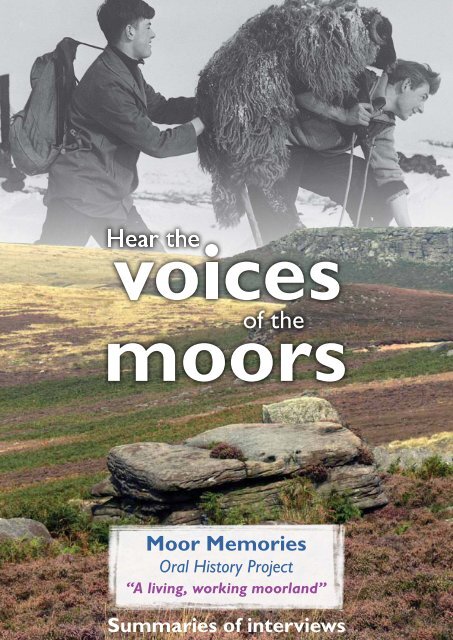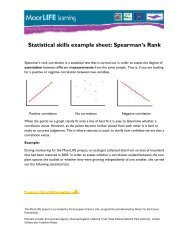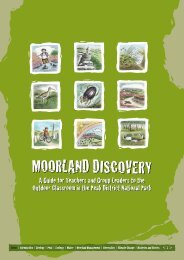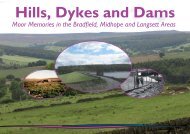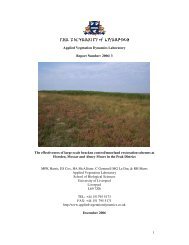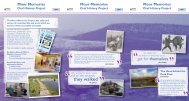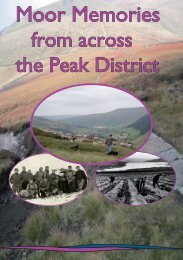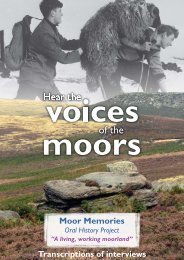Summaries - Moors for the Future
Summaries - Moors for the Future
Summaries - Moors for the Future
- No tags were found...
You also want an ePaper? Increase the reach of your titles
YUMPU automatically turns print PDFs into web optimized ePapers that Google loves.
Moor Memories Oral History ProjectSummary of interview contents1. Roger France – first interview2. Roger France – second interview3. Elizabeth Worsley4. John Eardley and Philip Sharply5. Dereck Nobles6. Clif<strong>for</strong>d Robinson – first interview7. Clif<strong>for</strong>d Robinson – second interview8. Don Johnson9. Ray Platts10. Rangers Group Interview – 111. Bam<strong>for</strong>d Workshop12. Flash School Workshop13. Ron Priestley14. Geoff Kaye15. John Littlewood16. Clarion Ramblers Longshaw Group17. John Bunting18. Mr and Mrs Frodsham and Janet Garlick19. Ian Stuart20. Bill Emmingham21. Holme Village Workshop 122. Rangers Group Interview 223. George Townsend24. Brian Gill25. Hayfield Day Care Group26. Terry Howard27. Margaret Bailey28. Brenda Smith29. Ken Harwood30. Fred Goddard31. Holme Village Workshop 232. Maureen Armes and George Hill33. Frank Harvey34. Arthur Quarmby35. David Wombwell36. Herbert Beardsell37. Ian Davidson38. Gwyn Fields39. Gerald Eastwood40. John Ownsworth41. Nick Smith42. Ian Hurst43. Linda Cawley44. Riona Shergold45. Ken Drabble1
1. Roger France – first interview - GamekeepingBorn in 1949Gamekeeping from 1962 onwardsThe role of <strong>the</strong> gamekeeperMoorland conservation (e.g. mowing bracken)Grouse shootingWildlife <strong>the</strong>n and nowControl of predatorsHea<strong>the</strong>r burning – why and how it is managedThe effects of wildfiresTasks of <strong>the</strong> gamekeeper throughout <strong>the</strong> yearDifference in grouse shooting in <strong>the</strong> past and <strong>the</strong> presentDriving and beatingGrouse buttsHabits and habitats of grouseWorking in winterGrouse shooting and sheep grazingGrouse shooting and walkersCommunication with <strong>the</strong> publicEffects of National Park and CROW ActAll terrain vehicles and mountain bikes2. Roger France – second interview – GamekeepingUsing horses on past grouse shoots (up till 1980s)Bottles getting broken when <strong>the</strong> horse bolted!How to work safely with horsesBracken mowing with a scy<strong>the</strong>Invasive nature of brackenSpraying bracken to control itMoorland edges – cornfields (1930s)Snailsdon Moor – ploughing to grow wheat, oats and barley <strong>for</strong> grouse“White ground” grassy moorland edges, not hea<strong>the</strong>r moorsReplanting hea<strong>the</strong>r3. Elizabeth WorsleyBorn in 1929Early life in GradbachDomestic lifeA family of ten childrenCollecting <strong>the</strong> shopping from FlashMacclesfield market on a SaturdayHaymaking with a pony and cartKeeping cows - Jerseys in Gradbach – rich milkElizabeth’s fa<strong>the</strong>r’s family in Middle HillsFamily in Poynton – taking eggs and butter to GladysTom’s car – having ridesElizabeth’s mo<strong>the</strong>r – born in Keswick, lived in Litton2
Married at Tideswell Church, moved to Gratton, <strong>the</strong>n Top Middle EdgeGreen’s Cottage, where Elizabeth was born – no running waterMoved to Gradbach - well by <strong>the</strong> side of <strong>the</strong> kitchen never dried upTaking milk in <strong>the</strong> donkey and cartDonkeys chasing each o<strong>the</strong>r with <strong>the</strong> cart on two wheelsKeeping a pig <strong>for</strong> meatPeg Inn sold pegs and gave a glass of beer with it to get round licence!Old mines? Water affected by <strong>the</strong> coal underneathNever enough sugar, especially in <strong>the</strong> warSchool in Leek between 12 and 14After 14 worked at home on <strong>the</strong> farmNo fruit off <strong>the</strong> fruit trees – too cold, no beesTypical mealsMilking at night and cleaningEverything was punctual. Fa<strong>the</strong>r was very strict. Couldn’t go outGetting marriedRelationships with familyGetting sweets <strong>for</strong> a penny (got twopence <strong>for</strong> taking <strong>the</strong> paper down)People were good to <strong>the</strong> childrenContinuation of interviewMarried lifeMove back to CloughElizabeth looks after keepers and chauffeurs at Wildboarclough post officeNot enough bathrooms!Opens small shop, trade taken away by supermarketsMove to Bank Top, still look after keepers and chauffeursLeaky roof at Crag Hall CottagesMove to current bungalowWhat were <strong>the</strong> moors like around Sniddles and <strong>the</strong> Roaches?Farms had improved <strong>the</strong> land but too stony and swampy to do any moreUsed <strong>for</strong> hay, but not very goodMajor Young had Sniddles farm <strong>for</strong> tax purposes<strong>Moors</strong> around Bank Top – Derby’s had looked after <strong>the</strong> estate moreStony but better land, haymeadows around <strong>the</strong>reBad summers – made silage. Good summers - made haySheep don’t like silage. Will eat haylage (half and half)Wea<strong>the</strong>r was often bad in summer4. John Eardley and Philip Sharpley - Farming around Wildboarclough1 of 4Farming in <strong>the</strong> 1940sGrowing food in <strong>the</strong> warMilk producing in wartime and after (“milkless days”)New tractor bought in 1937 – <strong>the</strong> end of using horses – tractor still runningtoday!Use of moorland – grazing sheep, subsidy <strong>for</strong> cattle grazing in summerCattle graze moorland to make better pasture <strong>for</strong> sheepSheep farming3
Introduction of motorbikesAttempts to plough <strong>the</strong> hills – subsidy <strong>for</strong> adding lime – moorland edgesMade <strong>the</strong> grass palatable <strong>for</strong> <strong>the</strong> sheepMat of dead grass in early 1980s. Killed off old grass and began reseeding.Use sheep to tread <strong>the</strong> seed inFields now reverting back to what <strong>the</strong>y came fromOvergrazing by sheep if left too long on moors, now <strong>the</strong>re is noticeablehea<strong>the</strong>r and o<strong>the</strong>r plants including bog asphodels <strong>for</strong> first timeNeed <strong>for</strong> monitoring thisGrouse and golden ploversSheep don’t disturb nesting birds2 of 4Improving <strong>the</strong> landGrouse shootingFarmers beating – interviewee got shot when 14 or 16!Got sandwiches, pop and 16 shillingsPick<strong>for</strong>d Moor was bestBracken was high enough to hide a horse and cartBracken ploughed in but roots remained. Good <strong>for</strong> growing potatoes onBracken cut <strong>for</strong> cattle bedding – 1937 up to 40sCutting with scy<strong>the</strong>Not so much around nowFarmer previous to interviewee did a flit due to not paying rent.1937-38 started ploughing to grow foodEvery field in Wildboarclough has been ploughed3 of 4Effects on grouse of sheep farmingPollutionWartime memories – POWs and bombs3 keepers looked after <strong>the</strong> areaGood years and bad years with <strong>the</strong> grouseFox hunting ban – has it had any effect? Not much?How <strong>the</strong> countryside works - “Can’t have one thing dominating <strong>the</strong> rest”Farmer has got to be versatileSnow ploughing – cleared <strong>the</strong> A54 – last time in 1980. Three years laterchopped arm off! Missed footbrake when winching wood with tractor (?)Tractor turned over and rolled on top of him. Stitched back on in hospital!4 of 4Winters and summersOldest building in Wildboarclough – old barn – used to keep cattleMowing with scy<strong>the</strong>s – an acre a dayGrowing cropsHand clipping sheepElectric shearers turned by handA big flock was 40 in <strong>the</strong> old daysStarted selling milk in 1932 – previous to that made own butterO<strong>the</strong>r local famers/characters4
Spreading muck – by hand and with a muck spreaderWater not fit to drink – and in lead pipesMoorland grips to dry out moors in 1952/53 – 46 miles of <strong>the</strong>m on this estateHad to keep <strong>the</strong>m clearWere ten feet deep at <strong>the</strong> end – cattle could get stuck in <strong>the</strong>mHas caused drainage and erosion – a new idea at <strong>the</strong> time and a wrong ideaDid <strong>the</strong>m all over <strong>the</strong> moors5. Dereck Nobles –Sheep farming around HolmeBorn 19351 of 2Photographer <strong>for</strong> tractor firmConnected with farming <strong>for</strong> his whole lifeAlso worked as a test driver <strong>for</strong> tractor firmStarted in 1959 after <strong>the</strong> warHolme Village is just in <strong>the</strong> Peak District and just on <strong>the</strong> 1000 foot contourSheep farming2 big changes – paving <strong>the</strong> Pennine Way and controlling grazing by fencingBreeds of sheepLot less sheep on <strong>the</strong> moors now, giving it a chance to regenerate1947 – “<strong>the</strong> winter of winters”Shepherds meetings – claiming unmarked lambs1963 – <strong>the</strong> frost was even keener – minus 23 in <strong>the</strong> villageHolme Moss transmitter 1981 – overnight heavy snow in April in <strong>the</strong> middle oflambing – kept on snowing.The keepers manage <strong>the</strong> moors – shooting syndicates, or by invitationLangsett House – who lives <strong>the</strong>re nowDidn’t used to overstock <strong>the</strong> moors, so that sheep could move around with <strong>the</strong>wea<strong>the</strong>rSheep are hefted (born on <strong>the</strong> hill). Never bought your neighbour’s sheep,because <strong>the</strong>y would go back.Old shepherd’s cabins on <strong>the</strong> moors, roofless now, stone built with a greyslate roof.Loaders and beaters on shootsRain gauges – up until <strong>the</strong> 60s – visited once a month by water board workersBurning hea<strong>the</strong>r – to get varying stages of growthIn a good summer grouse can have two broodsWorm can wipe out grouseKeepers worried about open access, but people generally follow paths2 of 2Army camp in <strong>the</strong> warPlane crashes on <strong>the</strong> moorsLife in <strong>the</strong> RAF – during National ServiceCauses of wildfires on <strong>the</strong> moorsRamblers and gamekeepers in 1950sPart time Ranger work at Dovestones (“Outer Mongolia”)Early 60s onwards – working as a rangerWorking with rescue team in <strong>the</strong> early days5
Climbing memoriesAvalanche at Dovestones in 1963 – Chew ValleyClimbing on <strong>the</strong> Edges in <strong>the</strong> Peak District – no fancy kit in early days!Getting lost on <strong>the</strong> moors - Follow a stream!<strong>Moors</strong> are busier nowPollutionFoot and Mouth in 19636. Clif<strong>for</strong>d Robinson – Holmfirth – first interview – Gordon Danks alsopresent - GamekeepingBorn in 1929, CarlicotesWalked everywhere. Fa<strong>the</strong>r was part time keeperKept hens and pig, grew vegetablesWorked as keeper himself after fa<strong>the</strong>r’s deathSheep went anywhere – too many sheep, caused over grazing – during <strong>the</strong>warFenced after this and hea<strong>the</strong>r has grown back – big issueWent to LadycrossPeat cuttingWhat a gamekeeper does<strong>Moors</strong> are better kept nowDisease affected grouse – <strong>the</strong>n put medicated grit outIn <strong>the</strong> war farmers grew corn and grouse ate corn on edges of moorsHea<strong>the</strong>r burning – burning strips. Knew when to burn – damp but not toodamp!Wild firesShoots – syndicate (half a gun – could shoot <strong>for</strong> half a day) paid per yearNever know how many grouse you have on <strong>the</strong> moor – don’t shoot at all if<strong>the</strong>re aren’t enough grouseGrouse follow <strong>the</strong> contours and windBuilding butts – from stone so sheep wouldn’t destroy <strong>the</strong>mCabins <strong>for</strong> shooting parties – mostly wood – had to maintain <strong>the</strong>mWere left open <strong>for</strong> walkersOpponents of blood sports pulled butts and cabins down at one pointPolice called on some occasionsWalkers mostly no problem – dogs could cause problem or leaving a gateopen on odd occasionSchools were <strong>the</strong> biggest culpritsOpen access – dropping matches could cause fire. If <strong>the</strong>y were responsible<strong>the</strong>re was no problem.Genuine hikers were fineNever know which person is going to cause a problemEgg stealing could be a problem tooWinters – once snowed in <strong>for</strong> 7 weeks, but had everything in and could liveout of <strong>the</strong> freezer – in 1970s. Swindon Lodge.1985 ground frozeGrouse will follow <strong>the</strong> sheep to find <strong>the</strong> hea<strong>the</strong>rCutting bracken with a scy<strong>the</strong>Forestry planting at Langsett – 19736
Magnum – houses all condemned and pulled down in 1950s. Village nowgoneLots of farms closed down because of pollution into reservoirCorner shops now closed down in villagesEffect of <strong>the</strong> warChanges to <strong>the</strong> moors – hea<strong>the</strong>r in <strong>the</strong> old days, sheep overgrazed this. Nowback again.Pollution – industry from Manchester said to turn <strong>the</strong> sheep blackHolme TV mast said to be coated with Buxton lime from limestone quarriesMast got iced up, 1958 ice brought Emley Moor transmitter downKeepers were born to <strong>the</strong> moors – passed from fa<strong>the</strong>r to son, brought up withitInvited to shepherds meetingsClose relationships with farmers as a keeper7. Clif<strong>for</strong>d Robinson - 2 nd interview - GamekeepingEarly days. Always interested in <strong>the</strong> moorsWinter of 47 - Sheep huddled under <strong>the</strong> walls and got buried by snow drifts,had to be dug outWanted to be a joiner but couldn’t get wood into <strong>the</strong> country because of <strong>the</strong>war, became a plumber insteadWent to Ladycross as part time keeper in 1972Landrovers replaced horses on shootsMoved to Holme in 1954 or 55Was a very friendly village. Mostly sheep farmersFarms shut down around reservoirs. Remember Dun<strong>for</strong>d reservoir beingbuilt.Woodhead tunnelMagnum Harvest Festival at Church – whole hamlet not <strong>the</strong>re any more – hada small sweet shop, church and pubFarming experiencesSmall farms, 50 acres maximum, 10 acres of cornWorking with horsesMade hay not silage until <strong>the</strong> war. People said it would turn inside of a cowrotten.8. Don Johnson – Baslow - RamblingBorn 1927Walking on moors in 1940s with Clarion RamblersTrespassing and gamekeepersGHB Ward – life and walking activitiesWhat we used to wearBrewing upCafes <strong>for</strong> afternoon teaLack of modern clothingBeing chased off <strong>the</strong> moors by gamekeepersWalking boots7
Harry Baxby – President of Clarion Ramblers – plaque on Back TorTaking shelter in shepherd’s huts and shooting cabinsWore cycling capes against <strong>the</strong> rain and sou’westersWent every Sunday – only had Sundays off work from steelworks etcCafes attached to farms – Alport Castles <strong>for</strong> instanceReading a map and compassWalk leadersGetting lost – Bleaklow <strong>for</strong> instance, main problem was mistWalking became easier with founding of Peak ParkNot free access until 2000Main challenge was walking on Kinder, but walking on Bleaklow is harderCan be dangerous placesNo rescue service in old daysWhat to do if challenged <strong>for</strong> trespassingWorking as a Ranger – how to deal with people, especially with dogsRamblers’ attitude to dogs on walksChanges on <strong>the</strong> moorsMoorland degradation and regenerationHow to balance leisure and regenerationFell runningFavourite places<strong>Moors</strong> – very quietForestry – cutting down trees proposed at AlportMore and more erosion of moorsIntroduction of Ranger Service has made changes – contributed tounderstanding and education of peopleOff-roading has been <strong>the</strong> worst thingMountain biking is a new thing – quite encouraged by Peak ParkCan be a problem on footpaths – sometimes can’t be heardCars have made <strong>the</strong> countryside more accessible to volumes of peopleClarion was <strong>the</strong> <strong>for</strong>erunner of <strong>the</strong> Ramblers – 1900sRamblers from Manchester tooWell known shops <strong>for</strong> hikers – not <strong>the</strong> variety available todayCamping in <strong>the</strong> old days was popularSeasonal changes – 1947 was <strong>the</strong> worst winter – had to dig out <strong>the</strong> sheep1963 bad but not as badStill went walking in <strong>the</strong> snow, took walking sticksWalking equipmentGHB Ward –Clarion handbooksHistory of violence and persecution – dedication of <strong>the</strong> people involvedKnown as hikers not ramblers.Resistance of <strong>the</strong> landowners to accessAccess but still private ownership9. Ray Platts – Bam<strong>for</strong>d – Cattle farming near Bam<strong>for</strong>dBorn in 1922 – frightened about economic collapse at that time!8
Born at farm at Ha<strong>the</strong>rsage owned by Colonel ShuttleworthSome land bought by public subscription in 1935 <strong>for</strong> bowling green and parkSchool in Ha<strong>the</strong>rsageFamily’s farms – very supporting.Had a lot of horses and foals – fa<strong>the</strong>r told tales about breaking in horsesShort horn cattle – delivered milk to village twice a day – people couldn’talways payRent was 7/6 an acre. Inflation and <strong>the</strong>n slump after <strong>the</strong> 1 st world warFa<strong>the</strong>r would walk cows to Bakewell marketFa<strong>the</strong>r gave milk to a newly married couple with a baby who had no moneyOften only had bread and jam to eatDomestic life - washed in cold waterHad a few sheep and shared a ram with a neighbourBack breaking jobs – clipping sheep and hoeing turnipsHad pneumonia at 15 – grew tall at that time!Moved to Bam<strong>for</strong>d in 1943Farmer <strong>the</strong>re had workers who were being called up, so family moved <strong>the</strong>reBro<strong>the</strong>r was in Air Force saw how good <strong>the</strong>ir Ayrshire cows were when inScotlandHas been a long process building a herdHad a milk round in village and put on wagon to SheffieldFa<strong>the</strong>r said train made <strong>the</strong> biggest difference to <strong>the</strong> valley – couldn’t cross <strong>the</strong>valley as easily and made people live by <strong>the</strong> clockMeeting wife during wartimeWar took <strong>the</strong> best years out of life, and bro<strong>the</strong>r and lots of friends killedPlane crashes onLiked wea<strong>the</strong>red (brown) bracken <strong>for</strong> calves and horses beddingGot permission from gamekeepers to collect bracken on Stanage – differentplace each yearSteam engines on <strong>the</strong> road Road block on <strong>the</strong> road during war timeWas in <strong>the</strong> home guard in Ha<strong>the</strong>rsageGot invitation to opening of Ladybower just be<strong>for</strong>e wedding.Remember spire sticking out of <strong>the</strong> water when reservoir first madeMore domestic memories – food and celebrations10. Rangers group interview 1 – Edale – How <strong>the</strong>y started and what aranger does(Discuss Coronation Street filming)Interviewees:Ian Hurst – Peak Warden’s Association in early 60s; volunteer warden afterthat; patrol ranger at 21; assistant warden at Crowden in mid 60s; full time in1970s; district ranger at Buxton after that. 1986 Nor<strong>the</strong>rn District, advisor <strong>for</strong>Countryside Commission in 1990s. Returned to National Park in 1995 – arearanger in Hayfield. Retired in 2007.Cliff Laycock – became warden in mid 60s, Eastern edges of moors aroundLangsett and o<strong>the</strong>r areas. Moved to Skye, also involved in Edale MountainRescue team9
Jack Ellmore – involved <strong>for</strong> 40 years, Edale and Eastern edges; moved toWhite Peak area. Now at LangsettDavid Millner – took Wardens’ training course (as did o<strong>the</strong>rs). Ollerbrook.Went to Stanage (still voluntary), <strong>the</strong>n Langsett, Tissington trailBill Darley – Had cottage at Upper Booth – appointed as assistant wardenwhen Tom Tomlinson was full time warden. Moved to Hayfield and hascovered lots of areaGordon Miller – camped at Edale as schoolboy, taken up on Kinder by FredHeardman. Started when very young as a volunteer, took training course atEdale. Worked at Eastern Edges - Stanage, learnt about farming at NorthLees Hall. Became full time “floating” warden <strong>the</strong>n Kinder, Hayfield,Castle<strong>for</strong>d <strong>for</strong> 30 years. Now volunteer againWhat does ranger do? Everything!National Parks Act included access land so wardens’ role written into <strong>the</strong>legislation. Tom Tomlinson was first one. En<strong>for</strong>cement role in early days.More involving and educating people now, as well as maintaining <strong>the</strong>landscape.Lots of vandalism in <strong>the</strong> early days (of cabins) – wardens got involved ra<strong>the</strong>rthan <strong>the</strong> policeUni<strong>for</strong>m introduced in 1974. Used to buy ex army gear be<strong>for</strong>e thatHad to en<strong>for</strong>ce <strong>the</strong> bye laws over issues like camping, fires, dogs, poachingetc. Changed since introduction of CROW actPoachers could be dangerousEgg stealing in <strong>the</strong> pastKeeping people off <strong>the</strong> moors during grouse shootsHunt saboteurs involved. Lots of negotiation involvedChristmas tree patrol on LangsettMonitoring usage of moors prior to access agreementsFoot and mouth inMade an igloo at Fairholmes were so bored!Redmires farmer would bring flasks of coffee laced with brandyEdale valley cut off due to Foot and MouthAlso involved in Mountain Rescue in <strong>the</strong> pastFour Inns in 1964 is <strong>the</strong> memorable onePrior to that farmers would lead rescues. After that need <strong>for</strong> more coordinatedsystem became clear(Shows photos of Four Inns rescue)Took longer to attend incidents in <strong>the</strong> past. People were worse equipped on<strong>the</strong> moors in <strong>the</strong> past as well.Dogs were an issue too – sensitive to criticise people’s dogs!Farmers used to (and still do) shoot dogs <strong>for</strong> worrying sheepDogs abandoned on moors as wellAno<strong>the</strong>r major concern was fires – 1976 was bad year – over 80 that summerDanger of ammunition exploding during fires<strong>Moors</strong> used <strong>for</strong> training during <strong>the</strong> war – Langsett – shells buried in <strong>the</strong> peatcome back to <strong>the</strong> surface – some live and had to get bomb disposal out toexplode <strong>the</strong>mNo guidance <strong>for</strong> <strong>the</strong>se issues, organisation and equipment was very basic10
Management now better organised, have learnt from past mistakes and luckyescapes – always moving <strong>for</strong>wardWardens used to run a ski run in EdaleA good example of <strong>the</strong> range of things rangers have doneBuilt own searchlight, powered by a gas bottle – almost too big to carryOne search between Edale and Crowden on Pennine Way – had flares whichset fire to <strong>the</strong> moorland alongside <strong>the</strong> Pennine WayFall from Stanage – same thing happened <strong>the</strong>re and elsewhereBriefing centres – basic conditions.1960 – Park bought Fieldhead, used a shed attached to thatThen moved into building when Visitors Centre opened – had a big pot-belliedstove which warmed everyone up as <strong>the</strong>y came off <strong>the</strong> hillAlso used bungalow from when railway was built in 1894O<strong>the</strong>r buildings used as briefing centresNorth Lees Hall was derelict at <strong>the</strong> time – restored <strong>the</strong> hall at that time(featured in Jane Eyre)Had to use spring to get waterNo rules or legislation in old days. Service was very diverse and had to do allits own maintenanceNow, may suffer through cuts, but visitors would have a poorer experience if itdisappeared tomorrow.Rangers interview 1 - continuationStarted with volunteers from rambling and climbing clubs – up to 1960.Then started appointing part time paid wardens. Volunteers still came out asa group sometimesMailed individual briefing every week from Tom TomlinsonBecame better organised and trained, standards were raised, in 60sMore change in 1970s as wellDid night navigation and bivvied out on KinderChanges in wildlife – has changed <strong>for</strong> <strong>the</strong> better – more raptorsNew phase now – rangers used <strong>for</strong> observation and monitoring vegetationGamekeepers’ attitudes have changed tooEducation now – is it right that people should be educated to degree level? Isexperience more importantEducation is increasingly important (schools, health walks etc)You marry <strong>the</strong> job – huge commitment – lots of relationship breakdownsamongst full time staffEssence to being a ranger is having lots of strings to your bow – danger ofconcentrating on one aspect onlyVoluntary training in Peak District National Park is uniqueWhy have a national park here?Role of <strong>the</strong> trespass movement in promoting care of <strong>the</strong> Peak DistrictGHB Ward and socialist movement – escape from <strong>the</strong> smoggy cityEven sheep are whiter now – take it <strong>for</strong> granted nowReturn of vegetation – regeneration not a new idea – has been tried in <strong>the</strong>past too11
Issue of paving Carbon storage – a new concern. But always worried aboutpeat disappearingSphagnum – <strong>the</strong>ft of sphagnum as well in <strong>the</strong> pastLitter and camping is a problem now11. Bam<strong>for</strong>d Workshop – Bam<strong>for</strong>d – Living near <strong>the</strong> moorsGeneral discussion with 5 interviewees, not named on recording.The filling of Ladybower reservoirWalking on <strong>the</strong> moors with <strong>the</strong> scoutsFarms taken over <strong>for</strong> reservoir building – no compensation – 1936Bilberry and mushroom pickingRabbits and rosehips during <strong>the</strong> warUsing bracken <strong>for</strong> animal beddingTerrible fogs in ManchesterRocks that <strong>the</strong> climbers used would be sooty from pollutionBiggest change to <strong>the</strong> moors is <strong>the</strong> increase in people; and regulationCouldn’t get fuel delivered during <strong>the</strong> bad wintersFarmers helped to clear <strong>the</strong> snow awayLong hot summers in 1950s and 1976 – led to firesFilling <strong>the</strong> car with blankets and tea to travel over <strong>the</strong> moors in cold wea<strong>the</strong>rUnofficial mountain rescue – being called out to helpMedical kits and stretchers kept on <strong>the</strong> moors (Stanage)Big searches <strong>for</strong> people missing on <strong>the</strong> moorsChanges in wildlife – used to be red squirrels12. Flash School Workshop – Flash – farming lifeInterview between pupils and Janet Garlick (nee Frodsham)Born in 1960 in Leek but lived at Goldsitch Moss (?) <strong>for</strong> 29 years [nb: justsouth of Flash]Can trace back 6 generations of Frodshams from <strong>the</strong> areaMo<strong>the</strong>r was a housewife; fa<strong>the</strong>r a haulage contractorTwo sisters and 1 bro<strong>the</strong>r (her fa<strong>the</strong>r had 17 siblings!)House built in 1716 – lived <strong>the</strong>re from 2 months old with her parentsDidn’t own <strong>the</strong> farm animals, but did help outShe was 6 when first got electricity – used Tilley lamps, candles and paraffinlampsCooked food on old fashioned range – this provided all <strong>the</strong> heat <strong>for</strong> <strong>the</strong> housetoo (no central heating)Played in <strong>the</strong> fields and on rocks (Ramshaw Rocks). Roamed <strong>the</strong> countrysideWent to Leek <strong>for</strong> shopping on bus (on Wednesdays)First time went on holiday was when she was 11 or 12yrs old to hergranddad’sWent to Flash School (52 children at <strong>the</strong> time)Left Primary School at 12; went to Warslow Secondary till 17Had sheep, horses, hens, ducks, geese, pigs on <strong>the</strong> farm – helped herd <strong>the</strong>sheep when <strong>the</strong>y were lambing – hard workHad a pet catAlways seemed warmer (but colder winters than today)12
Used to collect frog spawn from <strong>the</strong> pond; river between <strong>the</strong>ir farm andneighbouring one – tried ‘tickling’ troutLots of hay meadowsA lot of <strong>the</strong> land is no longer farmedExplains a little how <strong>the</strong> land has changed after it was sold by <strong>the</strong> Crewe andHarpur estateLand around where she grew up has changed – no longer farmed and hasgone back to bog and moorLack of management of hea<strong>the</strong>r moors <strong>the</strong>se days (past 20yrs)Used to be plenty of wildlife on <strong>the</strong> moorsFirst job was at Hintons Motor Factors – had to be <strong>the</strong>re at 7am and walked<strong>the</strong>re13. Ron Priestley – Hope – Sheep farming in <strong>the</strong> Hope ValleyBorn in Sheffield 1927Lived on hill farms in Ha<strong>the</strong>rsage and <strong>the</strong>n HopeHad sheep and later small dairy herd with milk roundMoved in 1946 to HopeShepherding in snow in 1947 winterDogs would smell out sheep and find air pipeWould <strong>the</strong>n dig <strong>the</strong>m outMainly in big hollow by Moscar and StrinesHard work - Used to go to a lot of dances as well, in BuxtonBig dance hall in Castleton, would arrange dances <strong>the</strong>reBurnt down in 1950Fires on <strong>the</strong> Eastern moors – 1938 – burnt from end to endDon’t need fire brigade thoughHea<strong>the</strong>r needs frost to growMore hea<strong>the</strong>r now than ever – but harder on some places than o<strong>the</strong>rsNew hea<strong>the</strong>r on Moscar (by gamekeeper’s bungalow)Fewer walkers 30 years agoFoot and mouth and threat of wildfire closed <strong>the</strong> moors and this kept <strong>the</strong>mundisturbedBracken clearance – during and at end of war. With a roller pulled by atractor. Would take several yearsNot a lot done now and this is a threat to <strong>the</strong> moorsUsed <strong>for</strong> bedding when mowed. Hard work to mow with a scy<strong>the</strong>Poisonous if <strong>the</strong>re is still some growth in it – will kill cattle but not sheep<strong>Moors</strong> are different nowSurprise View – used to be quarry – now covered with silver birchStone taken from <strong>the</strong>re to build Derwent DamsTop dams started in 1901 to 1915. Ladybower started in 1934.Ashopton and Derwent Village closed (shows pictures)Hand sheering sheep – techniques (shows pictures)Would take 3 minutes to sheer by hand, <strong>the</strong>n dipWool was packed and sent to Brad<strong>for</strong>d – all marketed through Brad<strong>for</strong>d(Shows photos from book)13
Forestry around <strong>the</strong> dams – built after thatBreweries in SheffieldPlanted hea<strong>the</strong>r around <strong>the</strong> trees. Now just trees. Used to be fenced off<strong>Moors</strong> were open – sheep were hefted (could roam free). Sold mutton notlamb. Tasted like venison – hea<strong>the</strong>r gave <strong>the</strong> meat a flavour.Farmers had <strong>the</strong>ir own mark to identify <strong>the</strong>ir sheep – still use <strong>the</strong> same marktodaySome brought off to lamb, but were better off on moors than eating richergrassShepherds meetUsed to wash sheep be<strong>for</strong>e <strong>the</strong>y were sheared - wool used to be full of soot“Long Arthur” and o<strong>the</strong>r quarrymen – from photographsPaper Mill near North LeesButchers shop in Ha<strong>the</strong>rsagePollution – must have affected <strong>the</strong> moors tooGranddad had milk round at turn of <strong>the</strong> century until 1940s. Seven differentmilkmen in Ha<strong>the</strong>rsage at <strong>the</strong> time, now only one.Bad winters – 1941, 1947 was worstShop was completely different – everything on displayMutton – comes from castrated male sheep. Too old and <strong>the</strong>y would gettoughNo one sold lamb as lambEffect of war – too many sheep on moors? Walked sheep to Bakewell on aSundayGranddad was a shepherd <strong>for</strong> Duke of Rutland on LongshawOllerenshaw’s at North Lees – went with horse and cart to sell produce inSheffield14. Geoff Kaye – Upper Midhope – Forestry, military use of moors and<strong>the</strong> coming of <strong>the</strong> reservoirsBorn 1954 in Upper MidhopeMo<strong>the</strong>r from village; worked in shop at Langsett, <strong>the</strong>n ThurlstoneFa<strong>the</strong>r originally farmer <strong>the</strong>n after war worked at waterworksWas only child in village <strong>for</strong> many yearsAs a youngster spent lot of time at one of local farms (John Walkers) helpingout with tasks – mostly done by hand in those daysWent shooting (+ poaching a little!), mole trapping, rabbits, ducks ondam…frowned upon by local gamekeeperShooting <strong>for</strong> food…more pheasants around since John left village!In winter pheasants come to house looking <strong>for</strong> foodCaught/shot foxes (predator control) – competition between farmers andgamekeepersTradition now gone due to changes in gun laws, loss of working farms (noneleft in village).Farms replaced with houses – most land around reservoirs owned bywaterworks. Didn’t want nitrates, fertilisers, manures washing into waterwaysso farms sold14
Some land taken by o<strong>the</strong>r farmers but restrictions on how <strong>the</strong>y can use itLand gradually returning to moorland / rough grass – some fields aroundvillage now in this stateSupposed to be better <strong>for</strong> birds / wildlife, but birds came be<strong>for</strong>eSome hawk species have returnedMore birdwatchers nowDuring war most of moorland was used by armyAfter war buildings occupied by people, families from all overSome local people born <strong>the</strong>reProbably people from <strong>the</strong> cities who were bombed out / evacueesSome families returned after war <strong>for</strong> holidaysBuildings demolished sometime in 1950sAno<strong>the</strong>r temporary village existed <strong>for</strong> dam workers at Langsett when damsbuilt - ’tin town’ Still being used by 2 families in early 1960sHad its own hospital (on lawn of pub)All removed by time new Langsett waterworks built (1985)Changes in attitude by water company about land use and access – no longeras concerned about contamination because of treatment worksThere used to be a reservoir keeper <strong>for</strong> each site; controlled access etcNow fewer keepers and less concerned about controlling access (footpathscreated around reservoirs; concessionary right to roam exists)Downside is people leave litter / rubbishLittle pollution from industry – most pollution (from Sheffield) went down <strong>the</strong>valley ra<strong>the</strong>r than up onto moorsDamage caused by armyAircraft wrecks: story of light aircraft landing in fieldGlider crash landed in garden – pilot killed (mid 1960s)Fa<strong>the</strong>r worked at waterworks (Barnsley Corporation) – lived in waterworkshouse until 1970 <strong>the</strong>n moved back to family home / farmMost people moved on when asked to but some gave verbal abuse –technically trespassingLots more walkers <strong>the</strong>seForestry - uncles were involved in tree planting; fa<strong>the</strong>r planted aroundMidhope DamTrees planted to cleanse water running off moors into reservoirs; alsocommercial timber use. Trees need to be managed (a lot weren’t).Management has improved but too late in some areasA managed <strong>for</strong>est allows grass / shrubs to grow beneath canopy; many ofthose around reservoirs not managed properly so timber of low commercialvalue / poor qualityLeft school became apprentice engineer at Hepworths, <strong>the</strong>n C&G MechEngineering at Barnsley College.Then worked at steelworks (Stocksbridge) – wanted to work outside.Followed by range of outdoor jobs15
Involved in digging ‘grips’ on moors, mainly clearing out / improving to allowaccess <strong>for</strong> <strong>for</strong>estry operationsAs young lad used to go grouse beating with school friends. Stopped whenstarted work.Farming stopped when it was grouse shooting season – farmers would workon moors. Community event; less so nowSolitude on moors – Pike Low highest point in areaBracken mowing (by hand – scy<strong>the</strong>) <strong>for</strong> animal bedding.Gamekeepers job now more difficult because of extra rules/regulationsFarmers have important role in countryside management15. John Littlewood– Penistone – Farming near PenistoneBorn in 1948Attended Bradfield SchoolGrowing up in LoadbrookWorking <strong>for</strong> Earl Fitzwilliam’s after leaving schoolWorking at clay minesThen, guarding, <strong>for</strong>estry and vermin controlMoved to DerbyKeeping and <strong>for</strong>estry work <strong>for</strong> Fitzwilliam Estates againShooting and moorland vermin controlLooked after sheep and farmland as well1980s went to Midhope as keeper and sheep farmerSheep farming calendarIn-bye land – rough grazing ground between farmland and moorlandSnowy winters – gave hay and mineral blocks to sheepQuotas <strong>for</strong> keeping sheep off <strong>the</strong> moorsChanges in <strong>the</strong> work – shooting more relaxed and social, now big businessBurning hea<strong>the</strong>rControlling brackenExperimented with hea<strong>the</strong>r seedFeeding <strong>the</strong> grouse in bad wintersTeam of people <strong>for</strong> hea<strong>the</strong>r burning – had to carry everything by foot in <strong>the</strong>beginningMidhope - bad moor to burn because of past fires during military trainingTechnicalities of hea<strong>the</strong>r burningFires out of control – fires in peat holes at Midhope – 1982 (?)Dukes Road fire – set off WW2 bombsBattery house to light decoy lights in WW2 – on Strines MoorMowing bracken with a “swipe” on Fitzwilliam EstateIn younger days used bracken <strong>for</strong> cattle beddingDraining of moors in old daysBilberry pickingCommercial <strong>for</strong>estry on Fitzwilliam Estate and at BradfieldNo health and safety precautions <strong>the</strong>n – one day’s training <strong>for</strong> explosives inmines! Same with farmingChanges in <strong>the</strong> moors – involvement of villagers in shooting in old daysA lot quieter in <strong>the</strong> past – only <strong>the</strong> odd hiker16
Wildlife – reintroduction of goshawks in 1955Hard <strong>for</strong> keepers when <strong>the</strong>y take grouseKeepers’ management of moors help wildlife like songbirds tooThere should be more understanding of what keepers and farmers do16. Clarion Ramblers Longshaw Working Party – Volunteering atLongshawDiscussion with several interviewees – Mr Allan, Colin Todd, George Thomas,Bob Priestley and o<strong>the</strong>rsTrack 1Volunteering, wardening and working at Longshaw since 1940s and 50sAnnual Clarion bonfires at LongshawChildren used to helpDonations and loans to buy <strong>the</strong> estateThe kind of work carried on now – outdoor activitiesEarly working parties (1950s and 60s) – once a monthMostly from SheffieldDid a walk once a weekClarion Rambler handbooksCafé closed from 12 till 1Holiday FellowshipTeas at Greenwood FarmCleaning <strong>the</strong> lake – used <strong>for</strong> swimming and skating on occasion in <strong>the</strong> pastBus travelWhat wardens used to do – Wardens’ bookletTrack 2Plaque to Harry Cook“Harry’s bridge”The ice house(Discussion of photographs)The roundel in <strong>the</strong> meadowKeepers lodges – now derelict – one had a piano in it – discussion of locationof old lodgesFormation of Clarion movementSongs and stories – Clarion song bookSinging on ramblesSheffield Rambling ClubNames of old Clarion membersGHB WardCampaigning <strong>for</strong> access to <strong>the</strong> moors after <strong>the</strong> second world warTrespassing on <strong>the</strong> moorsKeepers on <strong>the</strong> moorsHelping with moorland rescues17. John Bunting – Sheffield – Campaigning <strong>for</strong> access to <strong>the</strong> moorsBorn in Sheffield 1918 (Pitsmoor)Fa<strong>the</strong>r worked on railways (plate layer) but in 1920s recession wasunemployed <strong>for</strong> 4yrs. Hard times – mo<strong>the</strong>r took washing in17
Saturday trips as children to places like Fox House and RivelinJoined YHA when 16yrs old – started walking and campaigningGot involved in his first campaign in 1934 (calling <strong>for</strong> National Parks) – went toWinnats PassUsed to cycle outEarly groups mainly professional people; few working class folk – he was oneof firstHe unveiled a plague in Winnats celebrating early campaignsLarge numbers attended <strong>the</strong> early campaigns. Police presence but no troubleSpeeches about right to access land etc…you couldn’t walk on openmoorland without trespassing.Pressure <strong>for</strong> access increased after warLarge concentration of working class population surrounding peak areaKnew Benny Rothman and served on early committees with him in 1930sAnecdote about early days of Youth HostellingFirst holiday with friends – rode bikes to Lake District! Has returned nearlyevery year sinceCycled to Glasgow in same year to see Empire GamesEarly walks mainly on routes like pack horse routes across moors – onceknown as ‘salt routes’. Took steel / iron implements from Sheffield toManchester; brought salt and silks backHad to keep to routes as o<strong>the</strong>r land privately owned; gamekeepers patrolledwith big sticks. Trespassed but could run faster!Walked on Sundays (Saturdays part of working week)Involved in Advisory Committee <strong>for</strong> setting up Peak Park – hoped to obtainfreedom to walkFought <strong>for</strong> freedom in war, but nothing had changed after warTrained as anti-tank gunner at Langsett MoorJoined Home Guard and patrolled moors at nightHad to light fires on Totley Moor – can still see holes filled with water.Used as decoys against German bombersDoesn’t think moors have changed significantly, but lots more footpa<strong>the</strong>rosion.Even in early days (1940s) certain places (e.g. Black Hill) suffered fromerosionAttended regular rallies (1934 – 39) in Winnats. Held every year (names someof those who gave speeches)In 1945 rallies moved to Cave Dale as during war road put through Winnats1949 - National Park Act. Delighted till read small print – most of access landhad been left offAfter war things quietened down a bit / moved slowly.Formed SCAM (Sheffield Campaign to Access Mountains and Moorland) andwas first SecretaryStarted organised trespassesSome people were satisfied National Park was founded but o<strong>the</strong>rs weren’tbecause of <strong>the</strong> access issue so continued campaigningIn 1940s – 50s feels more children / families were involved in walking18
Clothing worn very differentTalks about walks done and being a volunteer warden (preceded MountainRescue). Patrolled Kinder / BleaklowTalks about how Ramblers Association was organised and links withManchesterBiggest change in his lifetime has been ability <strong>for</strong> all to access <strong>the</strong> moors18. Mr & Mrs Frodsham and Janet Garlick (daughter) – Farming in <strong>the</strong>Staf<strong>for</strong>dshire moorlandsBorn 1932 and 1940 respectively; married 50yrsMrs F from Leek; Mr F lived at Winking Man pub <strong>the</strong>n known as <strong>the</strong> MoorlandClubMoved to current house in 1960Talk about landownership changes in Roaches area – private land used <strong>for</strong>grouse – Mr F used to go beating (paid 10 bob a day)Much less grouse around <strong>the</strong>se daysMrs Smith (Shaw House) used to have grouse parties <strong>for</strong> those shooting (butnot <strong>the</strong> beaters). Beaters went to Royal Cottage…he was allowed a pint withhis dinner (but underage)Long days / hard work.Explains where <strong>the</strong>y went and anecdote about shooters shooting across road– law now changedMr F explains where he went to school – started at 5 till 14; stories aboutschool daysHorses used by most people on farms – no tractors till after warNo water or electricity when young – got water from trough.Water collected in barrels from guttersNow rely on spring but this dries up sometimes. Explain about using differentsprings in areaNo electricity till 1964During war had to plough up some land (meadow) <strong>for</strong> growing food. After warMinistry of Ag had scheme to revert land back – at no cost to farmers.Talks about using lime on land and how it changed <strong>the</strong> vegetationMoorland not used <strong>for</strong> crop growingUsed to have more hay meadowsThinks <strong>the</strong>re are less birds now (lapwings and curlews)Too many badgers / foxes / magpies; less vermin control practicedLess hares too – many killed off by bad winter (1947)Winters were a lot worse <strong>the</strong>n (every winter bad)People used to grow more of <strong>the</strong>ir ownShopping in Buxton on Saturday morningsAnecdotes about several local peopleTalks about farm work and how hard it was19. Ian Stuart – Bakewell – Walking on <strong>the</strong> moorsBorn 1931, ManchesterVisited moors as a child once old enough to travel on buses (with friends)19
First visit to Kinder Scout with his mo<strong>the</strong>r (age 9). Fa<strong>the</strong>r in RAF (wartime)but encouraged <strong>the</strong>m to visitExplains how <strong>the</strong>y travelled to moors by bus / train and walks <strong>the</strong>y didOnce old enough made regular use of Youth HostelsWore shorts in all wea<strong>the</strong>rs; tried a variety of waterproofs – tells of using armygas capesEarly rucksacks terrible to wear and inefficient (but cheap!)During wartime moors were empty with little erosionOriginal line of Pennine Way badly drawn as goes straight across boggyareasTalks of ‘outwitting’ a gamekeeper on Bleaklow / KinderFinding aircraft wreck (Flying Fortress?) in late 1940sWinter 1947 – very bad conditions. Food drops at Edale. Went walking, gotbus to Hayfield, saw man on skis (first time ever)Explains about early RAF Mountain Rescue based at Harpur Hill – set up torescue aircrewAfter <strong>the</strong> war walking/climbing clubs and outdoor groups proliferated – peoplehad more leisure time. Started climbing in 1952 after being in ArmyCan remember Black Hill and o<strong>the</strong>r places be<strong>for</strong>e <strong>the</strong>y were badly erodedTalks about difference following Clean Air Acts<strong>Moors</strong> now much busier – misses <strong>the</strong> absence of people.Often saw white hares (north side Kinder). Probably fewer nowBetter access after war lead to some areas being vandalisedRoaches popular – saw wallabies and llamas. Released from private zooduring warLess skylarks nowSupported start of National Park – desirable idea. However, disappointed bybuilding of Hope Cement Works just prior to this. Can be seen from manyareas20. Bill Emmingham – Moorland Centre, Edale – Rambling, WoodcraftFolk and access to <strong>the</strong> moorsBorn and brought up in SheffieldJoined Woodcraft Folk (1942) – Sundays camping in summer, walking inwinter.Woodcraft Folk aim - get children out of city / smoke; in Sheffield <strong>for</strong>med bymembers of Independent Labour Party (March 1929) –how it was <strong>for</strong>med /organised (political background)Met regularly, <strong>for</strong>med strong bondsEarly camping on outskirts of SheffieldFirst summer camp at Youlgreave (1943), <strong>the</strong>n Edale (1944)At Youlgreave during VJ celebrationsEvery member had a woodland name - his was ‘Brown‘Barning’ – staying in barns overnightJoined ‘Clarion’ -1947. Knew some of those involved in open accesscampaigns.Early traditions and walking…Clarion routes20
Rejoined Woodcraft Folk (1962) – movement has changedSetting up Lockerbrook activities centre with Terry HowardWalking at Win Hill and building of damComing across 4x4s on Houndkirk MoorChanges e.g. clothing.More people using <strong>the</strong> areas and more publicity about using itTaking own sandwiches to cafes and buy a pot of teaYouth Hostelling in Peak District1947 – getting stranded on after walking to Stanage.Training exercises - early mountain rescue through Clarion groupMountain Rescue now more professionalMoorland fires more prevalent nowWalking Black Hill with group of ladsWards Piece – disc paid <strong>for</strong> by man from South AfricaUsed to see white hares frequently in winter – not nowLess curlews – used to hear regularly in 1940s – 50sHang gliders / aircraft and more people spoiling <strong>the</strong> tranquillityMr Emmingham – photograph memories: took New Years Day 1981 – snow,icy, gale. Looking across Kinder.Visiting Kinder on New Years DayCamped once at Kinder DownfallAlways a challenge walking on Kinder21. Holme Village Workshop 1 – Holme village - Peat cutting on HolmeMoss(Various contributors, including interviews with Carlton Mellor and DerekBailey)Barrage balloons and searchlightsPeat blowing off <strong>the</strong> moorsCycling up Holme MossRed Cabin – shooting cabinPackhorse routeWea<strong>the</strong>r at HolmeCommercial peat cutting in 1947Peat cutting rights & techniquesPlane crashes on <strong>the</strong> moorsFirst sight of a helicopterPlaying in streams – sulphur waterSponsored walk on Black Hill in 80s – black, muddy morass – now greenInterview with Carlton MellorEarly lifeMemories of <strong>the</strong> building of Holme Moss transmitter, where parents workedMo<strong>the</strong>r taken to <strong>the</strong> top of a mast in a bucket!Watching a rugby match at <strong>the</strong> transmitter (1953)Getting snowed inIce on Emley Moor transmitter21
Memories of Black HillAeroplane crashesInterview with Derek BaileySalvaging material from plane wrecksFirst experience of plastic came from this22. Former Rangers group interview 2 – Moorland Centre, Edale – Therole of <strong>the</strong> warden/rangerPeople present:David Milner, Ian Hurst, Bill Darley, Gordon Miller, Cliff LaycockTrack 1Discussion over photographs that <strong>the</strong> group had brought inHow <strong>the</strong> rangers became involved in fence and stile repair/building and o<strong>the</strong>rground-worksOriginally mostly a patrolling role and liaising with landowners / gamekeepersTrying to stop trial bikes on StanageBye-laws and bye-law en<strong>for</strong>cement – main role in early daysStopping someone with a shotgun - having to go to courtKeeping records of incidentsFarmers expected prosecutions!Serious incidents dealt with by <strong>the</strong> Police (e.g. poaching)Track 2No uni<strong>for</strong>m – wore what was appropriateDevelopment of warden/rangers uni<strong>for</strong>m – armbands to badgesOrigins of <strong>the</strong> term Ranger - keeping order.Full-time staff had vehiclesOriginal Fieldhead building (Moorland Centre)First centre <strong>for</strong> Ranger Service - Edale.Spread of <strong>the</strong> service over <strong>the</strong> National Park - access agreements spreadfur<strong>the</strong>r afieldFootpath work / responsibilities evolved – taken on role from DCC.Signing and waymarkingTrack 3Opening of Tissington TrailLegal responsibility <strong>for</strong> Pennine Way - experimenting with different pathbuildingmaterialsDevelopment of footpath management - work with <strong>the</strong> National Trust and <strong>the</strong>Pennine Waystone flagsBlack Hill fire beacon (1970s – Silver Jubilee?)Black Hill quagmire, loss of peat and restorationLoss of peat on Mam TorErosion exposing new levels of archaeologyTrack 422
Ranger vehiclesMuttley <strong>the</strong> Ranger Service horse,Bagpipes played in <strong>the</strong> National Park!Track 5Dogs and dog walkersAn incident with stock lead to <strong>the</strong>m not being able to take dogs outProblem dogsFilming with John Noakes when Shep went missingWarden training course (Dove Dale)Track 6Walking home as a child through <strong>the</strong> Chinley Tunnel!Warden’s Land RoversLand Rover training courses (at Solihull)Edale StationVolunteer rangers got <strong>the</strong> train to workNoise of hobnail boots from walkers at SheffieldPeak Warden AssociationTrack 7Stayed at OllerbrookComradeship in <strong>the</strong> ranger serviceWorking with <strong>the</strong> local farming communityPeak Warden AssociationSad that PWA doesn’t exist nowRegular social eventsSocial aspect continued by Edale Mountain RescueLocal people invited – breaking down barriersTrack 8Beginning of Mountain Rescue, <strong>the</strong> development of mountain rescue groups(including Edale Mountain Rescue)Glossop - first group (1959)Had to be a Ranger to join Edale team (no longer applies)Initially run by National Park - roles separated in 1980sEdale MR based at Hope nowHenry <strong>the</strong> dog (Henry) stretchered down from Kinder after a heart attackPeople missing on <strong>the</strong> Pennine WayThe Four Inns incidentMissing Scout group at CrowdenHelicopters (rescue and training) – early 1960sTrack 9Fire fighting –Arga Cats.Could get stuck in groughsCentaur - bigger and more powerful than Arga CatHelicopters used <strong>for</strong> carrying stoneLosing Arga Cat on a steep slopeEarly fire-fighting very basic and learnt on job …Became more professional - portable reservoirs and helicopters.23
Increased liaison with emergency services23. George Townsend – Life in drowned villages be<strong>for</strong>e <strong>the</strong> reservoirscameBorn in 1929Early life in AshoptonWhat <strong>the</strong> village was likeMoved to Thornhill in 1939Went to Bam<strong>for</strong>d SchoolWorked at Aston Hall – four generations of family had done soMarried and lived at Edale when children were youngLater life in Hope Valley, sheep farmingChanges in farming practices24. Brian Gill – Hope – Walking in <strong>the</strong> snowBorn in Sheffield in 1928 (Ne<strong>the</strong>r Edge)Listening to early Radio Sheffield broadcastsMoved to Norton LeesSheffield BlitzRambling with his older bro<strong>the</strong>rWalked over Totley Moor, past firing range to LongshawCold winters during war – ice skating in Graves ParkWinter 1947 heavy snows – started snowing end of JanuaryWea<strong>the</strong>r patternsCaused chaos – most of bus services stopped but tram cars running alongvalley bottoms.Hostelling and walking - winter 1947: headed <strong>for</strong> Edale YH. Walking on top ofdeep snow. Walked to Castleton following day via Mam Nick. Had to walkhome from Hope!Deep snow - just top of road sign showing! Headed <strong>for</strong> Fox House – tookshelter overnight at Longshaw LodgeMoved to Hope when he retired (worked in steelworks: River Don Works /Vickers). Started as apprentice (at 15yrs). Wife was a schoolteacher.Keen walker and cyclist; joined Scouts and went campingYouth Hostelling with bro<strong>the</strong>r and friendsJoined Ramblers Association; walked abroad and met his wife through thisFred Herdman – first NP RangerMountain Rescue exercise / training.Changes in Hope Valley –conversion of farm buildings to residentialFew changes to Moorland. Bracken.25. Hayfield Day Care Group – Life in Hayfield; mountain rescue; sheepfarming in winterInterview with Arthur HuddlestonChurch warden in Hayfield24
Bracken cutting and beatingFarm workDelivering milkWinter of 1947Walking over KinderWartime plane crash on KinderWartime bombingsHome Guard and ARPPeople leaving Manchester because of <strong>the</strong> blitzInterview with David BlythInvolvement with Kinder mountain rescue teamPainting <strong>the</strong> trig pointsPaving moorland pathsTraining and activities of mountain rescue teamInterview with John GillSearching <strong>for</strong> sheep buried in deep snowMo<strong>the</strong>r’s experience of rambling on <strong>the</strong> moorsChanges to <strong>the</strong> moorsDuke of Edinburgh Award groups on <strong>the</strong> moors26. Terry Howard – Redmires – Mass trespasses and leading walksWoodcraft FolkFed stories about Kinder ScoutHostelling at Edale Youth HostelFirst walk up GrindsbrookWeekends walking, hostelling or camping with Woodcraft FolkEwden Valley – leading a group aged 15.Using map and compassTrespassing on Bradfield <strong>Moors</strong>Quotes GHB Ward “You’ve never been anywhere unless you’ve been lost”Abbey Brook trespassTalk a little about GHB Ward (but bad audio)Politics and rambling in Sheffield hand-in-handO<strong>the</strong>r trespasses (e.g. Stanage Edge)End of access struggle - CROW Act (2000)1982 - 50 th anniversary of Kinder TrespassFinding bits of flint as a child1982 reunionSheffield Campaign <strong>for</strong> Access to MoorlandStill finding things -burial mounds and Bronze Age settlement sitesHistory of people on <strong>the</strong> moorlands and relating it to us nowBlack Hill and <strong>the</strong> erosion/degradationBig Moor/Totley Moor – red deer have appearedBirds of prey still suffering from being shot/poisonedLandowner who has destroyed moorland by turning it intoLots of little pieces of moorland have been lost25
27. Margaret Bailey –Hayfield - Working as one of <strong>the</strong> first femalerangersBorn in 1924Joined Ranger Service at 40 in 1964Walked on <strong>the</strong> moors from an early ageReads from article she wrote in 1980 about woodland on slopes of KinderPlane crash siteSees a Brocken spectre at Kinder DownfallMysterious message carved in stoneStrange rites on <strong>the</strong> moorsBomb disposalDecorating a shooting cabin at LongdendaleMoorland flora – species of Cloudberry named “Warden” in her honourNight exercises and o<strong>the</strong>r wardening memoriesMountain haresAwarded MBE in 1995First woman rangerBased in Hayfield and Glossop28. Brenda Smith – Running a pub in EdaleBorn in 1914Early life in BaslowMoved to Edale after Second World WarConditions at <strong>the</strong> Church HotelGuests and regularsSocial events in <strong>the</strong> villageWalking clubsFamous visitors (including Barbara Castle)Filming in Edale – Charlie BubblesRunning <strong>the</strong> pub single handedMeeting her husband, who came from DaleheadLocal politicsBuilding of <strong>the</strong> Church HotelRamblers on Kinder – <strong>the</strong>n and nowStaff who worked at <strong>the</strong> pubThe Nag’s HeadLocals and visitors29. Ken Harwood – Wirksworth – volunteer rangerInterview on Mr Harwood’s work as a volunteer ranger in <strong>the</strong> Hayfield andKinder areasBegan walking in area in late 1940s (be<strong>for</strong>e NP and Ranger Service set up)Lived in Stockport – got bus to Hayfield <strong>the</strong>n walked; not aware of problemswith gamekeepers etc (access movement was earlier)Relied on public transport, so early trips limited to Kinder area1954 – Volunteered with Edale Ranger (Warden) Service (run by TomTomlinson)26
Youths ‘stone-rolling’ (knocking down stone walls) and campersUpholding access agreements and byelaws made with landownersPatrolling moors closed <strong>for</strong> shooting.Couldn’t close public footpaths round edge of KinderPatrolling in pairsBig changes on KinderNational Trust fencingRights to dig peatSeen as an ‘in<strong>for</strong>mation service’ ra<strong>the</strong>r than policing roleWarden equipment and authorityPay and hoursSetting out routesRanger centresDCC Ranger (1971) – covered parts of Derbyshire outside NP.Many of early Peak Park volunteers ended up working elsewhere in <strong>the</strong>countryA typical working dayNags Head pub - In<strong>for</strong>mation Centre be<strong>for</strong>e FieldheadCarried a whistle, map/compass and first aid kitRescue equipment -Nags HeadClothingFreedom on moorsWorked in factory - getting out at weekendsWildlifeEdale Mountain RescueRescuing a trapped climber using chip shop fat!Volunteer Ranger Service started in May 1954Part-time Ranger in early 1960s till 1971Evenings on <strong>the</strong> moorsUnprepared / ill-equipped visitorsGamekeepers / agentsFewer grouse on Kinder and BleaklowWhite hares not as common nowAccess agreements“Pennine Rambling Club”Changes in moorland areas -erosion, footpathsContinuation: Early days - travelling to Peak by bus, meeting up after at DalesCafé Hayfield30. Fred Goddard – Farming on Broomhead moorBorn in 1929Working <strong>for</strong> local gamekeeper in 50s and 60s“Fever hospital”Measuring <strong>the</strong> rain gaugesThe moors during wartimeHelping on <strong>the</strong> farmMoorland ploughed up <strong>for</strong> crops during wartimeGrouse shooting on Broomhead moor27
Building of <strong>the</strong> reservoir and subsequent depopulation of Ewden ValleyLiving in StocksbridgeWinter of 1947Working at <strong>the</strong> steelworksBilberry and mushroom picking on <strong>the</strong> moorsCollecting rosehips <strong>for</strong> <strong>the</strong> war ef<strong>for</strong>t(Looks at maps)Derelict buildings in Ewden valleySubmerged structures in <strong>the</strong> reservoirsOld pubsPlane crashes on <strong>the</strong> moorsOld names from mapsMore gamekeeping memories – burningWartime defencesBuilding <strong>the</strong> reservoirsEwden villagePlanning and access issuesWater qualityLife be<strong>for</strong>e domestic electricity and gas supply31. Holme Village Workshop 2 – Life in and around HolmeDiscussion with Kenneth Denton, Gordon Hallas, Shirley Simmonds, ArthurQuarmby and Herbert BeardsellUsing bracken <strong>for</strong> packagingUses of sphagnumCloudberries on <strong>the</strong> moors near HolmeReseeding of <strong>the</strong> moorsPeat cutting expeditionsTools <strong>for</strong> cutting peatHow rights to cut peat came aboutReduction in pollutionCondition of <strong>the</strong> moors – <strong>the</strong>n and nowBuilding of <strong>the</strong> reservoirsFloodingBeagle hunting“Adopt a trig point”Shooting rights and gamekeepingFossilised roots found in <strong>the</strong> peatUse of sledges – practical <strong>for</strong> steep hillsidesSmall scale farming in <strong>the</strong> pastIndustrial peat cutting enterprise after second world warForestry plantations – now being removed32. Maureen Armes and George Hill – Life in and around LangsettMemories of past residents and dwellingsDepopulated after building of <strong>the</strong> reservoirsWartime bombings28
Life in <strong>the</strong> communitySchooldaysLife revolved around <strong>the</strong> farmsUse of horsesHome made butterPig keeping etcSoldiers stationed in <strong>the</strong> villagePubs and clubsChristmas and May DayEveryone shared <strong>the</strong>ir vegetablesHelping with grouse shootsPast cafesMemories of Langsett HouseWalks across <strong>the</strong> moorsMemories of past residents of LangsettBasic facilitiesWellsSwimming in <strong>the</strong> quarryHard work involved in past ways of lifeChristmas traditionsBilberries and o<strong>the</strong>r fruit pickingOpening of <strong>the</strong> water treatment worksDestruction of <strong>the</strong> village33. Frank Harvey – Farming and <strong>for</strong>estry work near Brightholmlee(Discussing old photographs while interview is in progress)Nature of farm workFire caused by thunderstormWorking <strong>for</strong> Forestry CommissionTree planting, cutting bracken, fencingPloughing with horsesBuying livestockLocal old mill workingsFeeding animalsLivestock marketsKilling pigsOld buildings no longer in existenceGrowing mushroomsTree felling with an axeMeasuring tree planting distances by strideMusical traditions at Christmas timeWhere <strong>the</strong> railway line used to runBuilding <strong>the</strong> damsMore discussion of old photos – <strong>for</strong>estry work around reservoirsBuilding <strong>the</strong> reservoirsAccident while working with a chainsawLand girls29
34. Arthur Quarmby – Peat cutting in <strong>the</strong> Graveship of HolmeRole as Chief Constable of <strong>the</strong> Graveship of HolmeHistory of graveships – peat cutting rights on <strong>the</strong> moorsTools used <strong>for</strong> peat cuttingThe Holmfirth tigerArchaeological excavations – discussion of photosBuilding of <strong>the</strong> reservoirs – closing of farmsteadsManagement of woodlandExemption which allowed peat burningGraveships made up of townshipsPeat cutting in <strong>the</strong> present day35. David Wombwell – Ashover – Walking on <strong>the</strong> moors fromManchesterEarly 1950s in Manchester (Didsbury)Beaverbark Park Baptist Church; regular group visits to DerbyshireTrain from Didsbury to Chinley (or Hayfield). Walked over to Edale andreturned from <strong>the</strong>re. Walking down Jacobs LadderBlisters as only had normal shoes; older group members would have nailedbootsOften Kinder Scout enveloped in mist; can’t remember people usingcompasses; navigated using OS 1” map…never got seriously lostSometimes varied route and found interesting thingsInterested in archaeology– thought he’d found a stone axe. Manchestermuseum - right shape, but wrong type of stone (gritstone not flint)Found small caves/tunnels in <strong>the</strong> peat (Edale Cross and Brown Knoll area).Hasn’t seen <strong>the</strong>se features sinceMoved to Derbyshire when got married36. Herbert Beardsell – Working <strong>for</strong> <strong>the</strong> water companiesWorking as a reservoir keeper <strong>for</strong> Yorkshire Water on reservoirs aroundHolmeLandslipsChecking <strong>for</strong> leaksReading rain gauges – colleague got lostWent in twos after accidentInspecting <strong>for</strong> pollution<strong>Moors</strong> were more closedGrazing on <strong>the</strong> moorsMoorland regenerationO<strong>the</strong>r duties of a reservoir keeper – walls to keep people outWalking <strong>the</strong> perimeterBypassing a reservoir if pollution occurredSwimming in <strong>the</strong> streamsTeenagers tombstoning and playing in <strong>the</strong> overflow of reservoirsMowing bracken or adding lime to control it30
Co-Operative societiesWildlife around <strong>the</strong> moors – hares and deerStudies of peat depthsCatch pits and gripsThe working day on <strong>the</strong> moorsPumping water between reservoirsFish in <strong>the</strong> reservoirsSafety issues concerning <strong>the</strong> reservoirs and damsInspecting <strong>the</strong> pipes – changes that technology has broughtPeat blowing off <strong>the</strong> moorsWater is full of peat – “Langsett tea”Clearing silt trapsGeneral discussion with o<strong>the</strong>r people presentBoundary marker (<strong>for</strong> old Cheshire boundary) – taken down from moorsOld “characters”37. Ian Davidson – Sheffield – climbing memoriesBorn 1950Walking, climbing, ice climbing, skiing, potholing, canoeing.Started about 14 or 15 years oldWent to school in north Manchester – walking / climbing group.Volunteer work in Sal<strong>for</strong>d, taking kids out at weekendsWalking and climbing in late teensSleeping in caves on <strong>the</strong> edgesOften hitch-hiked from one place to ano<strong>the</strong>rVolunteered at Birchfield Lodge (outdoor centre) in Hope – taught navigationand walking skills to children from Sal<strong>for</strong>dMoved to Sheffield - access to Peak DistrictChanges in climbing (e.g. equipment)Made some of his own early equipmentClimbing now safer - increased standards & more popularDivision between University climbers and working class climbersNever used to train <strong>for</strong> climbingUsing new climbing equipment and getting stuckIce climbing on Kinder Downfall38. Gwyn Fields – Sheffield – skiing on <strong>the</strong> moorsBorn in 1955Has skied on peak district moors, but not in recent yearsCross-country skiing above Woodhead Pass. Occasionally has seen o<strong>the</strong>rpeople on skis, but not commonIce-climbing up face of Mam Tor (1980s) this39. Gerald Eastwood – Working <strong>for</strong> <strong>the</strong> water companiesStarted working <strong>for</strong> <strong>the</strong> water authority in 1958Nature of <strong>the</strong> work and <strong>the</strong> working dayChecking rain gauges seven days a weekKeeping people off <strong>the</strong> ga<strong>the</strong>ring grounds31
Developed interest in <strong>the</strong> bird life of <strong>the</strong> moorsFishing rights and <strong>the</strong> fishing clubUsed to walk <strong>for</strong> milesReduction in bird numbersMore birding stories – peregrines, owls, ospreys and buzzardsTypes of fish found in <strong>the</strong> reservoirFly fishing and poachingSightings of kingfishersIssue of public access to <strong>the</strong> reservoirs edgesO<strong>the</strong>r activities around <strong>the</strong> reservoirs – quarrying, biking and quad bikingMotorbike accidentBuilding of Holme Moss transmitterFires on <strong>the</strong> moorsIsle of Skye pubMore fishing stories40. John Ownsworth – Military uses of <strong>the</strong> moorsMilitary use of <strong>the</strong> moorsShooting range built at Midhope in 1941Shells on <strong>the</strong> ground at Low MoorRemains of camps on <strong>the</strong> moorsAnti-aircraft guns at LangsettCatenary defences <strong>for</strong> <strong>the</strong> reservoirsExamples of bombs dropped on <strong>the</strong> moorsTanks units stationed on <strong>the</strong> moorsNissan huts and NAAFI buildingsFires caused by <strong>the</strong> shootingAmerican soldiers stationed on <strong>the</strong> moors as wellWartime in<strong>for</strong>mation was censoredPlane crashes on <strong>the</strong> moorsFarm commandeered by <strong>the</strong> armyGuards and security to stop people going on <strong>the</strong> moorsArtillery range at BradfieldMore memories referring to photos and articles41. Nick Smith – Moorland Centre, Edale – Search and Rescue DogAssociationBorn in 1961Search and Rescue Dog Association (SARDA) - training organisation <strong>for</strong>mountain rescue personnel to work with search dogs in <strong>the</strong> mountainsBuxton MR team - involved with SARDA through this.Volunteered as a ‘dogsbody’ i.e. person who waits on moors to be foundwhen dogs being trainedSARDA trainingHow a search dog works and finds a human scentQualities of a good search dogIncreasing urban searches (e.g. missing children, Alzheimer’s sufferers)A trained dog equals 20 humans of area coverage32
9 search dog teams cover <strong>the</strong> Peak District…works as a team operationalongside Mountain Rescue teamSearch and rescue in bad conditions on KinderDog and handler are re-assessed24/7 call-out systemMountain Rescue is a charity funded by donations and all volunteersRely on farmers and landowners allowing <strong>the</strong>m access to land <strong>for</strong> trainingAlso rely on volunteers who act as ‘dogsbodies’42. Ian Hurst – Doveholes – Mountain RescueBorn in 1943President of Buxton Mountain Rescue TeamWarden Service (late 1950s / early 1960s).Volunteering at EdaleGeorge Garlick was Head WardenWardens got involved in ‘rescuing’ people; Mountain Rescue ‘evolved’ fromthisPeople mainly travelled by train so focal points were Edale and HayfieldFirst incident he was involved with (1964) - ‘Four Inns Walk’Prior to this - no regional teams or co-ordination between teams1965 – meetings in Buxton with all Peak District rescue teams (+ police). Ledto setting up of regional organisation (comprising 7 teams)Training exercises and range of knowledge neededTypes of incident – 2 types: searches and ‘known location’All members are first aid trained (>60% are trained in Casualty Care)More professional and better equipment –stretcher designPersonal equipmentRadios now much better - used to rely on runnersDifficulties with communication and using Farey pistolRadios now provided by Police –direct comms with o<strong>the</strong>r emergency servicesEmergency vehicles – drivers have Police driving trainingWater rescues – assisting searches along river banks and canals etcAlso trained in basic helicopter awarenessMoorlands are better managed nowNational Trust / National Park work on ‘slabbing’ footpathsMore work to protect and revegetate moorland areasGully blocking – potential danger to users once gully has filled with peatywaterWill rescue livestock and dogs – rely on goodwill of farmers to allow access toland <strong>for</strong> trainingEarly access issues (1920s onwards)Incident in 1925 on Kinder.Early search and rescue relied on local police officers and farmers etc43. Linda Cawley – Sheffield – Woodcraft, rambling and singingBorn in 1953; lived in SheffieldInvolvement with moors through <strong>the</strong> Woodcraft Folk –14yrs old.Lockerbrook Farm - DofE Award33
Basil Rawson –Woodcraft Folk leader - also a leader on <strong>the</strong> DofECompass and map workWalking <strong>the</strong> moors and hillsBus to Ladybower -walking to Lockerbrook in <strong>the</strong> darkBig walk on Saturdays, singing in <strong>the</strong> evening, <strong>the</strong>n ano<strong>the</strong>r walk on SundaysCaught last bus on Sundays from Fairholmes (4pm).Singing on busLearnt to play guitar so played at Woodcraft Folk meetings: sings and plays“The Manchester Hiker”Mentions ‘peat bog jumping’ on KinderTaught about <strong>the</strong> history of <strong>the</strong> Kinder Trespasses etc by Basil, BillEmmingham and Terry HowardGetting lost on Kinder when quite young – Mountain Rescue called outPolitical / social influence of Woodcraft FolkSings “The Banks Are Made of Marble”Visits to <strong>the</strong> countryside with parents and grandparentsSocial education, healthy exercise, discovering wildlife etcSings: “This Land is Your Land” by Woody GuthrieConnection between walking and singing – talks about singing on <strong>the</strong> buscoming back to SheffieldSings: “Out Into The World We Wander”Strong tradition in Woodcraft Folk of sharing songsTalks about how popular climbing is now amongst young peopleSupports groups that introduce youngsters to <strong>the</strong> outdoorsFinishes with <strong>the</strong> “Campfire Carol”44. Riona Shergold – Sheffield – a young person’s experiences on <strong>the</strong>moorsBorn in 1999. Has been involved through walking, camping on moors.Was carried as a baby up GrindsbrookWhen 4 or 5yrs old walking it again and moaned a lot!Member of Woodcraft Folk – walking and o<strong>the</strong>r activities on <strong>the</strong> moorsClimbing on <strong>the</strong> RoachesHas ‘bivvied’ on <strong>the</strong> moors…camping without a tent.Wildlife Trust – every month went to Blackamoor to check <strong>the</strong> Highland cattle,gates etc were ok.Once it was deep snow and couldn’t find <strong>the</strong> cows so had to call farmer. Thenfound <strong>the</strong>mCattle on moor <strong>for</strong> grazing and stops it growing too muchHas helped SARDA – acted as a ‘dogsbody’ to help train <strong>the</strong> dogs.45. Ken Drabble – Moorland Centre, Edale – Early days of <strong>the</strong> Peak ParkBorn 1934 in New MillsLong involvement with <strong>the</strong> National ParkCould see Kinder Scout from his bedroomRoyal Marines - National Service; <strong>the</strong>n asked if he would help MountainRescue at New Mills (about 1960)Practised on Kinder; saw advert in local paper <strong>for</strong> part-time.34
Talks about early years in Warden ServiceBecame one of first 6 part-time NP Wardens; Tom Tomlinson was HeadWarden; George Garlick was Deputy Head WardenBecame first Warden/Ranger in Longdendale <strong>the</strong>n moved to Fieldhead toreplace George GarlickEventually became Chief RangerTalks about how <strong>the</strong> role changedEarly on National Park negotiated a number of access agreements withlandowners; this <strong>the</strong>n necessitated providing a Warden Service, later tobecome Rangers to make sure people behaved and abided by <strong>the</strong>agreementsEaster camping in Edale Valley - tented village.Changes to moorland environment. Early moves to protect and regenerate –many areas had been overgrazedPaving of footpaths (e.g. Pennine Way)Tackling moorland firesDykes – not firebreaks but to allow shooters to move around without beingseen by <strong>the</strong> grouseEarly role of <strong>the</strong> Warden -guiding people to where <strong>the</strong>y were allowed to walk.‘Right to Roam’Meeting Lord Sand<strong>for</strong>d (Sand<strong>for</strong>d Report) in early 1970sEarly days of <strong>the</strong> Joint Planning BoardHard winters (e.g. 1947)Allotments - so more self sufficientWea<strong>the</strong>r patterns on <strong>the</strong> moorsThe infamous Four Inns Walk tragedyThe creation of <strong>the</strong> Pennine Way by Tom StevensonModern Rangers35


